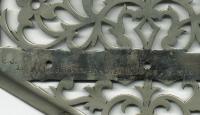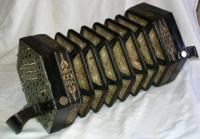-
Posts
85 -
Joined
-
Last visited
Everything posted by Mark Stayton
-
I don't know about "often", but a Crabb I once owned had them. Here is a photo of one of the endplates.
-
I've used XETrade (www.xetrade.com) for international transactions to the UK and Australia, and have been satisfied with their service. I've found their service fees to be significantly less than those of the bank. They will let you do either a direct wire transfer or issue a bank draft to the recipient in the currency of your choice.
-

Noel Hill"s Concertina Classes
Mark Stayton replied to Mary Ann Robison's topic in Teaching and Learning
Mary Ann, I am a five-year veteran of Noel's Ohio school (2001-2005) and wholeheartedly recommend his seminars. It's a focused, intent environment, and you're brain will be full by the end of the week, but you'll come away with more than you imagined and have plenty to work on until the next Noel Hill school! Medical issues kept me from attending this year, but he's giving a workshop 2-1/2 hours from me in early December, and you can bet I'll be there! Jack Mullen wrote a report on the 2003 Ohio school from the beginner's perspective; it's on the Noel Hill website at: http://www.noelhill.com/nhics_2003_oh_mullen.html -
Rhomylly, Alas, you'll not have the opportunity to set foot in Andy's Front Hall. Andy Spence has essentially retired, and all they're selling these days are the remnants of their inventory. A shame, really, as there doesn't seem to be anyone to take their place. I loved getting their catalogs and visiting with them at The Pipers' Gathering in Vermont and, of course, buying stuff!
-
Are any other C-Netters planning on attending the Pipers' Gathering in Killington Vermont next weekend, August 11 - 14th? I'll be there with a bunch of pipes and my Carroll. There aren't any classes geared towards 'tinas, but there are usually a few in evidence at the Friday evening meet-and-greet and at sessions throughout the weekend. Here are links to the Pipers' Gathering website and Event Program
-

In Defense Of The Old-fashioned Cd
Mark Stayton replied to bellowbelle's topic in General Concertina Discussion
I am similarly annoyed with the genre classification on CDs. Just about everything I own is either "folk" or "celtic" or "other" according to CDDB or freeDB. In other words, useless. I've used one of the free mp3 tag editors to change the genres to things that make more sense (at least to me) for creating playlists, like "Northumbrian" or "Uilleann" or "Concertina". Heck, I've even got "Boermusik" and "Icelandic folk". You don't see those in the genre pull down lists! -

Thummer(tm)-brand Jammer Unveiled!
Mark Stayton replied to Plamondon's topic in General Concertina Discussion
Jim, I think this decision may cost you some sales to "high-end" users such as Chris and others who own dedicated sound modules. On the other hand, I think your approach is spot-on for the broader market. Chris, if I understand Jim Plamondon's comment correctly, the data transfer capability of a MIDI cable is too low to support the volume of MIDI messages that are transmitted by the jammer, so you wouldn't be able to use it with your sound module even if there was a MIDI cable interface. -

Holiday Instrument Wish List
Mark Stayton replied to Greg Jowaisas's topic in General Concertina Discussion
I spent thousand$ on a Greg Jowaisas case, and got a free Carroll concertina! Awesome deal, act now! -

Traditional Music And 'classical' Theory
Mark Stayton replied to keeper's topic in Teaching and Learning
What a fascinating thread! I'll step off into the deep end here... I came late to music theory. I came even later to being able to read music, being an aural learner for almost thirty years. I agree with Keeper's assessment of music theory as a "toolkit", at least for my own case. It also opened the door to concepts beyond the dots, which I'll get to in a moment. Keeper's original post questioned where people got their knowledge of theory. I took a community college class in music theory, which was fine for the basic theory. I later took theory classes at workshops, which gave insight into how the theory is applied, such as chord progressions and substitutions, when and how to use them (in general, not applied to a specific musical culture). Later, I read Helmholtz and began a slippery slope into the physics, physiology and psychology of music, and I started wondering about things such as: Why do justly intoned intervals sound "best"? Why does a 7th draw the listener to the tonic, and why does the music seem "unresolved" if this doesn't happen? What makes each key have its own "color"? Why do these phenomena seem to be almost universally experienced by listeners? Are these things specific to Western music, or is it a natural part of the physiological and psychological response to music? Are there similar phenomena to be found among the "new" tones in, for instance, Harry Partch's microtonal scale, or among other forms of non-Western scales? For that matter, do these non-Western systems evoke still more physio/psychological phenomena that are unknown in Western music? I never should have read Helmholtz... If I had to go back and do it all over again, I think I would have taken much more music theory. As it is now, I haven't time enough to practice, much less plumb the depths of physiology or psychology! One man's (slightly tangential) perspective. -
Mike, When I got the instrument, the buttons were quite wobbly in their holes, as the old (and I suspect original) bushing felt was completely compressed. One of the first things I did was to re-felt the bushing boards with piano key bushing felt; that's the red ring you now see around the buttons. Made a huge difference in making the action quieter and improving my own accuracy at hitting those sometimes infernally narrow pin buttons. Of course, it's possible that the bone buttons were replaced at Aldershot Rd, and the old original button bushings were added at that time. But why? Were the narrow bone buttons somehow less durable than the wider ones? I've no experience with the narrower buttons, as the only Jeffries I've seen with bone buttons all had those "fat chubby monsters". What *I* want to know is, what are those brown stains on the bellows papers and how did they get there? Perhaps an incident with a wayward bit of draught in a dark pub during a session? Maybe that's why the bellows have lasted so long - they've been seasoned!
-
Mike, The full stamping, which runs beneath the handrest, is "C.J. 12.ALDERSHOT.ROAD.KILBURN.N.W.6". There's a thread about the stamping here. The photo links on the thread no longer work, but here's a pic of the stamping. Edited to add photo
-
The Jeffries has been sold, pending receipt of payment.
-
Didn't you see that little curly-cue in the fretwork, it's clearly a "J". What more proof do you need? In with the good air, out with the bad air, in with the good air...
-
With the recent acquisition of Carroll #008, the time has come to bid farewell to my Jeffries 31 button C/G anglo concertina. This instrument has metal ends, 4mm diameter metal buttons, and the original 6-fold gold-tooled bellows. It is stamped “C. Jeffries Maker” between the buttons on the right end, as well as on the right and left sides. The fretwork and stampings indicate that this instrument was probably made during the 102 Praed St. era, between 1872 and 1893. It has the standard Jeffries button layout, with a C/C drone button on the left thumb, and is tuned A440. The instrument was professionally serviced in November 2003. Case included. $6250 US, plus insured shipping. Email or PM for pictures and inquiries.
-
I saw the rosewood burl ends of Roy's instrument at Wally Carroll's shop during last month's midwest Noel Hill school, just days after Wally delivered #008 to me. As you might expect, the redwood is redder, while the walnut is more brown. Both burls look great, though I found the rosewood burl to be a little more ornate than the walnut. I don't know if that's true of the two woods in general, or if it's specific to the veneers that Wally selected. Either way, burl rules!
-
There's a picture of #8 here.
-
Congrats, Roy, she's a beauty! So what did you do first, play it or disassemble it?
-

Funny Comment From Tsa Screener
Mark Stayton replied to Michael Eskin's topic in General Concertina Discussion
For several years, I've been alerting the screeners to the unusual item they're about to see as the bag disappears into the machine. "They're bagpipes", or "it's a concertina" usually gets the instrument thru X-ray without having to open it up. But it occurs to me that this is just the sort of Jedi mind trick that a more nefarious type might employ to pre-condition a screener to an item that really should be inspected. So while I'm glad I don't have TSA folks manhandling my instruments every time I go thru security, I don't have a warm fuzzy feeling about the whole process. -
Anticipation... An-ti-suh-pay-ay-shun... Congrats, Roy, you're gonna love it!
-

International Anglo Cd Launch Concert
Mark Stayton replied to Chris Timson's topic in General Concertina Discussion
Thanks for the additional info, Alan. I'm looking forward to listening to it. -
Found this over on the Chiff & Fipple Uilleann Pipe forum (thanks, MarcusR!): Best Practice is a new CD-audio, mp3 slowdown and pitch compensation software. It looks and works very much like the "The Amazing Slow-Downer", but it's free. So far it is only for Windows platforms. Here's a link to the web site: BestPractice And here are a couple of performance comparisons: Playback Speed Adjusment: Amazing Slow-Downer: 20% to 200% Best Practice: 50 to 150% Pitch Adjustment: Amazing Slow-Downer: +/- 12 semitones Best Practice: +/- 3 1/2 semitones
-

International Anglo Cd Launch Concert
Mark Stayton replied to Chris Timson's topic in General Concertina Discussion
Chris, Do you have any information on where this CD can be purchased after its release? -
After so much debate, it is clear that modern science is unable to provide a satisfactory explanation for this phenomenon. Logic dictates that we look elsewhere for an answer. Fans make concertinas (and other instruments) warble because God wants them to. See, isn't that simple?
-
Yep, and the dots given didn't always match what was taught by ear. So this year's Zen question is, which version of the tune will "stick"? ommmmm.....
-
I have the Carroll layout. I found it quite easy to adapt to, coming from a Jeffries layout.




